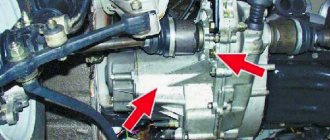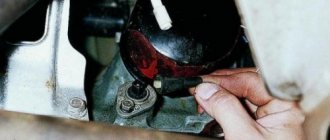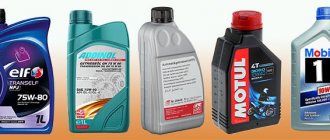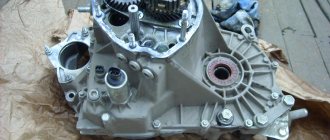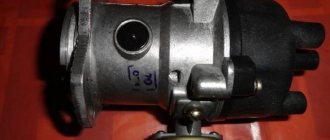April 29, 2015 Lada.Online 111 449 18
AVTOVAZ installs the same type of power units on its models, so the process of changing the oil in the Lada Kalina, Priora, Grant, Vesta, Niva or XRAY engine is similar. Let's look at the process of changing engine oil in VAZ engines, and also talk about some of the features of this procedure.
AVTOVAZ installs the following engines on Lada cars:
| Engine model | Volume, l | Power, hp | Number of valves, pcs | Engine oil volume, l | Installed on cars |
| VAZ-21114 or VAZ-11183 | 1,6 | 81 | 8 | 3,5 | Granta and Kalina |
| VAZ-21116/11186/11189 | 1,6 | 87 | 8 | 3,5 | Granta, Kalina 2 and Priora, Largus |
| VAZ-21126 | 1,6 | 98 | 16 | 3.2 (2.9)* manual transmission 4.4 (4.1)* AMT | Priora, Kalina, Granta and Kalina 2 |
| VAZ-21127 | 1,6 | 106 | 16 | 3,5 | Priora, Kalina 2, Granta |
| VAZ-21126-77 | 1,6 | 118 | 16 | 3,5 | Granta Sport |
| VAZ-21128 | 1,8 | 98 | 16 | 3,5 | Priora |
| VAZ 11194 | 1,4 | 89 | 16 | 3,5 | Kalina |
| VAZ 21129/21179 | 1,6/1,8 | 106/122 | 16 | 3,2 (2,9)* (1) 4,4 (4,1)* (2) | Vesta, Lada XRAY |
| VAZ 21214 | 1,7 | 81 | 8 | 3,75 | Niva 4x4 |
| H4M | 1,6 | 110 | 16 | 4,7 (4,2) | XRAY |
| HR16 | 1,6 | 114 | 16 | 4 | Lada Vesta |
* - when changing the oil (with replacing the oil filter) (1) - stamped oil sump (AMT) (2) - cast oil sump (manual transmission)
See also the features of changing oil on Renault engines: K7M or K4M.
The maintenance regulations state that the first oil change in the engine should be done after 3 thousand kilometers, and then at each maintenance (after 15 thousand kilometers) or once a year, whichever comes first.
You will need : warm up the engine to operating temperature, prepare new engine oil and filter, a “17” wrench, an oil filter remover (or a large screwdriver), clean rags and an empty container (4 l).
Types of motor oils
Historically, mineral-based oils obtained from the distillation of petroleum were the first to appear. Sometimes it was mixed with castor oil (for example, this technology was used by Castrol, hence its name).
Such oils were sufficient for use in low-powered engines, although they had noticeable disadvantages: their viscosity depended significantly on temperature, mineral oils quickly oxidized and polluted the engine.
If the first problem was solved by creating seasonal oils (summer and winter), then the second was solved only by frequent replacement.
The development of the chemical industry has made it possible to stabilize and improve the properties of motor oils: thanks to viscosity modifiers, it was possible to create all-season mineral oils; a large number of anti-friction and detergent additives allow mineral oils to work successfully in highly loaded engines.
The payoff for the low price of mineral oil is the preservation of a weak point - a low resource, because, in addition to useful work, additive packages also counteract the negative qualities of the base oil itself.
Synthesis of base oil allows you to obtain a significantly higher quality product, but at a significantly higher price.
Synthetic motor oils, depending on the production technology, may have different compositions.
Polyalphaolefin oils are the most common - the technology for their production is the cheapest. However, in a number of qualities they are superior to polyester oils - for example, their volatility and flammability are much less, and their viscosity is more stable.
Manufacturers often use polyester oil as an additive to the polyalphaolefin base to improve the quality of the oil at a lower cost than all-polyester oil.
Mixing a synthetic base oil with a mineral oil produces the so-called semi-synthetic. In fact, such oils usually contain no more than 20% synthetic base oil. Such measures make it possible to obtain a more stable motor oil, increasing its service life compared to mineral oil, and also to stabilize its viscosity.
Fuel quality
Fuel affects the frequency of oil changes, primarily due to the possibility of sand, dirt or water being introduced into it. All this almost always happens at unverified gas stations.
- Oil, in addition to chips and scale from natural use, also absorbs excess dirt, which in theory should not have been there.
- This significantly reduces its service life and accelerates aging. And frequent oil changes can neutralize all the negative effects of low-quality fuel.
Why do you need to change the engine oil?
Few people can immediately describe all the functions performed by motor oil.
In fact, there are only three of them:
- Lubrication. The most important job of motor oil. In modern automobile engines, the loads on parts are very significant, hence the high requirements for engine oil. That is why modern motor oils contain high amounts of anti-friction, extreme pressure and viscosity-stabilizing additives (up to 20-30 percent). However, operation at high temperatures and contamination by gases breaking through the piston rings lead to aging of the oil - the effectiveness of the additive package decreases. The drop in viscosity of the engine oil is best seen: the used oil is much thinner than at the time of filling. A significant decrease in oil film strength, combined with aging of the anti-friction additive package, increases engine wear.
- Cleaning. Even the best oil cannot completely combat engine wear. It is important that the wear products of the friction pairs are retained by the oil so that they are retained by the oil filter. This is ensured by a package of detergent additives, which also do not last forever. Since the days when only low-quality mineral oils were available, there has been a common misconception that darkening of the oil means it is oxidized and needs to be replaced. In fact, the darkening of the oil is precisely the result of the work of a package of detergent additives, which allows the oil to retain all contaminants in its mass, preventing them from settling.
- Cooling. It is engine oil that cools the most heat-loaded engine components, for example, by spraying it onto the bottoms of the pistons. Thus, the oil is constantly in contact with parts heated above two hundred degrees, which accelerates its oxidation.
Calendar? Odometer? Engine hours? Fuel?
As long as the car is under warranty, it is better to address all “oil” questions to the service technicians. But then everything depends on the operating conditions of the machine. Conventionally, all cars can be divided into three large groups.
A summer resident's car.
The annual mileage is at most a couple of thousand kilometers, mostly from and to the dacha. In general, it almost always stands and only sometimes drives.
Weekend car.
Travels mainly from Friday evening to Sunday evening. As a rule, driving is suburban, the annual mileage is ten to two thousand kilometers.
City employee's car.
He drives every day, constantly getting stuck in traffic jams. The annual mileage is small - about tens of thousands of kilometers.
It is clear that our division into groups is arbitrary, but the principle is clear. The recommendations for changing the oil are also clear. Let’s say that for the mentioned summer resident (and such drivers constantly call the editor with this very question!), we recommend that they be guided only by the calendar. A year has passed - change the oil, even if the odometer readings have hardly changed.
How often should you change your engine oil?
The main problem is that it is impossible to accurately estimate when a particular oil will significantly lose its properties in a particular engine.
Even if you take two identical cars, they can be used differently:
- Frequent and short trips accelerate the aging of the composition compared to long ones; city use is harder on motor oil than driving on highways.
For example, the amount of deposits formed in the engine in urban operation is 10-30% higher, depending on the quality of the oil.
The quality of the fuel also significantly affects changes in the composition of the oil: the use of high-sulfur fuel increases oil contamination, especially when warming up, and increasing acidity disrupts the functioning of the additives.
Oils of different compositions have different service lives.
Thus, mineral and semi-synthetic oils force manufacturers to introduce a fairly high amount of additives to compensate for the suboptimal properties of the mineral base. At the same time, when creating synthetic oil, the necessary properties can be incorporated into the base itself.
This is why synthetic oil ages longer - aging and degradation of additives have less impact on its properties.
Oil characteristics
Viscosity, specifications, manufacturer tolerances - all this also affects the frequency of oil changes, as well as its suitability for a particular model in principle. To increase the service life of your car, you can use oil recommended by the manufacturer itself.
If the oil turns black as a result of its operation, then this is great news - the oil cleans the engine well.
How to determine the optimal oil change interval for a car?
The simplest method is to refer to the manufacturer's recommendations.
For example, Peugeot sets the engine oil change interval for Russia at 10,000 kilometers.
This standard is lower than, say, for Western Europe: the manufacturer takes into account more difficult operating conditions of the engine, and therefore faster aging of the oil.
Another French manufacturer, Renault, sets the oil change interval for gasoline engines at 15,000 kilometers, and for diesel engines at 10,000. At the same time, it indicates the need to halve the service interval in difficult operating conditions (long idling, short trips).
Indeed, standing in a traffic jam with the engine running does not increase your mileage, but the oil ages faster than usual.
It is worth noting that oil change intervals are specified by the car manufacturer, subject to the use of recommended oils. If you fill the engine with cheap semi-synthetic and, especially, mineral oil, you cannot expect it to last as long as synthetics. Thus, when using lower quality oils, it is necessary to reduce replacement intervals. For most modern mineral oils, a replacement after a mileage of 5,000 kilometers would be reasonable; the average life of semi-synthetics is no more than 7,000.
Synthetic oils, no matter how their manufacturer insists on increasing the service life of their product by several times, it would be reasonable to change them after a mileage of 10-12 thousand kilometers.
Required volume
Before buying motor oil, you need to decide on the volume. The best option is to purchase a 4-liter canister, which will last for a long time. This is convenient, because you can add the remaining liquid as the liquid is consumed, without worrying about buying a new one every time.
Well, now specifically about the one-time filling volume. The engine model plays an important role here. The VAZ 2110 used two engine variations. This is an 8-valve and 16-valve engine. In the first case, the volume of the oil sump is 3.2 liters, and in the second - 3.5 liters.
How long does it take to change synthetic oil in a VAZ 2110 and VAZ 2114 engine?
Indeed, the manufacturer, according to Notice No. 41635, normalizes oil change intervals for motor oils of API SG and SJ quality groups, which are long outdated. So after how many km should you change the oil? In this case, the frequency of oil changes is set at 10,000 kilometers, which in difficult conditions is reduced to 5-7 thousand.
It would seem that higher quality oils should have a longer service life in these engines. But if you compare these figures with the recommendations of other manufacturers, you can see that oil change intervals for all car brands are almost equal.
Therefore, you should not increase the service mileage when using modern synthetic oil - no one can guarantee the consequences of such savings.
About Longlife oils
The “Longlife” label does not mean at all that the driver should forget about changing the oil for a year. This oil is intended exclusively for vehicles manufactured after 2000 and with such certification. In this case, the on-board computer may recommend changing the oil after 30 thousand kilometers.
Such oils are more expensive, but better quality and more durable.
How to change the oil in a Renault Logan engine?
The procedure for changing the oil yourself may vary in complexity depending on the configuration and generation of the car. Thus, on modern Renault Logan 2nd generation, access to the oil filter is much more difficult due to the changed layout of the engine compartment and attachments.
On cars of the previous generation, especially in poor trim levels, the filter is much more convenient to remove.
It is most convenient to carry out the work on a lift, removing the crankcase protection. However, here you need to take into account that it is secured with M6 bolts, which often break even on cars with low mileage. In this case, you need to be prepared for the need to drill out the debris.
The protection may not be removed, but it should be taken into account that when unscrewing the oil filter, a noticeable amount of used engine oil will fall on it.
Next, use an 8 mm square wrench to unscrew the drain plug of the pan. While the oil is draining, the oil filter located in the front of the cylinder block is unscrewed. Its seating surface is cleaned and a new filter is installed, before this the sealing rubber is lubricated with oil.
It is a common belief that the oil filter must be filled with oil before installation. In fact, this does not make sense - to expel air from the lubrication system to the oil pump faster through a dry filter. When the engine oil is drained, the drain plug returns to its place. Please note that its O-ring is disposable and must be replaced.
The filler neck on Renault Logan engines is conveniently located, and filling oil will not be a problem. Having filled the crankcase to the upper mark on the dipstick, you need to start the engine, let it run a little and turn it off.
Next, you need to add oil so that its level is again just below the upper mark of the dipstick or reaches it. It is also necessary to take into account that the eight-valve engine and the sixteen-valve engine have different filling volumes
Didn't find the information you are looking for? on our forum.
Oil filter device
As a rule, along with changing the oil, VAZ 2106 owners also change the oil filters. Let's figure out what this device is and how it works. By design, oil filters are divided into:
- modular;
- collapsible;
- non-separable.
Collapsible filters have a long service life and high cost. All that is required of the car owner is to periodically change the filter elements.
Non-separable oil filters have a much shorter service life, which is understandable: these are disposable devices that the driver simply throws away after they are completely dirty.
Finally, a modular filter is a cross between a collapsible and a non-separable filter. The housing of such a filter can be disassembled, but only partially, in order to remove the filter element. The rest of the design of such a filter is inaccessible to the user. At the same time, modular filters are more expensive than collapsible ones.
Whatever the filter housing, its internal “filling” is almost always the same. It is shown schematically in the photo below.
Oil filters on the VAZ 2106 have a similar design, differing only in the housings
The filter housing is always cylindrical. There are a pair of valves inside: one is direct-acting, the other is reverse-acting. There is also a filter element and a return spring. In addition, all oil filter housings have holes. They are located next to a rubber o-ring that prevents oil from leaking out.
Filter elements can be made of different materials. On inexpensive filters, they are made of ordinary paper, which is impregnated with a special composition, then folded into an “accordion” shape and placed in the housing of the filter element. This design allows you to increase the filter surface area several times and improve the quality of oil purification by 12 times.
Oil filter filter elements are made of ordinary paper with special impregnation
The purpose of a direct bypass valve is to allow oil to flow into the engine when the filter element is severely clogged. That is, the bypass valve is, in fact, an emergency device that provides continuous lubrication of all rubbing parts of the engine, even without preliminary oil filtration.
The check valve prevents oil from entering the crankcase after the engine is stopped.
From all that has been said above, we can draw a simple conclusion: the type of oil filter installed on the VAZ 2106 is determined only by the financial capabilities of the motorist. If he wants to save money, then the best option would be to install a modular or collapsible filter. A good choice would be MANN products.
MANN filters are in constant high demand among VAZ 2106 owners
CHAMPION modular filters also have a good reputation.
A good alternative to MANN filters can be an oil filter from CHAMPION
Yes, this pleasure is not cheap, but then you will have to spend money only on new filter elements, which are much cheaper than new disposable filters.
If your financial capabilities do not allow you to buy a reusable device, then you will have to limit yourself to a non-separable filter. The best option is the NF1001 filter.
Disposable non-removable filter NF1001
Frequency of oil filter replacement
The VAZ 2106 manufacturer recommends changing oil filters every 7 thousand kilometers. However, mileage is far from the only criterion for replacement. The driver should periodically monitor the condition of the engine oil using a dipstick. If dirt and various debris are visible on the dipstick, it means that the filter needs to be changed urgently.
Driving style is another factor that influences the frequency of oil filter replacement. The more aggressive it is, the more often these devices will have to be changed.
Finally, if the car is constantly operated at high temperatures, in heavy dust, dirt and in off-road conditions, then the filters will also have to be changed more often than the manufacturer recommends.
